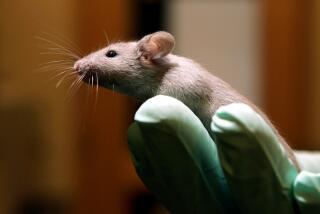Scientists create stem cells purged of carcinogens used in process
Borrowing a biological cut-and-paste trick from bacteria, scientists have created the first personalized stem cells for patients that are free of the cancer-causing viruses and genes needed to make them, according to a study published today in the journal Cell.
The stem cells, derived from skin samples provided by five patients with Parkinson’s disease, were first transformed back to the undecided state of cells in an early embryo. Then they were used to make the dopamine-manufacturing neurons that are lost to disease.
The technique removes a key barrier to using a special class of stem cells called an induced pluripotent stem cell, or iPS cell, to create replacement parts for patients that could be transplanted without risk of rejection -- the ultimate goal of regenerative medicine.
“This is a major advance in the field,” said Dr. Marius Wernig, an assistant professor at the Stanford Institute for Stem Cell Biology and Regenerative Medicine, who wasn’t involved with the study.
The reprogramming of skin cells into iPS cells, which have the potential to become any type of cell in the body, is one of the hottest areas of biological research. The cells seem to offer all the benefits of embryonic stem cells without any of the ethical drawbacks. They are also ideally suited to making genetically matched tissues for patients, such as insulin-secreting islet cells for people with diabetes or brain tissue to treat stroke victims.
The reprogramming process requires that scientists turn on a handful of genes that are active during early embryonic development but dormant in normal skin cells. Most researchers rely on infecting the cells with viruses to do this job. But these viruses may also lead to cancer, as can some of the genes used for the reprogramming job.
Dr. Rudolf Jaenisch, a stem cell researcher at MIT and the Whitehead Institute for Biomedical Research in Cambridge, Mass., and his colleagues found a way to remove the viruses and genes once their work was done.
They engineered three viruses that contained the reprogramming genes -- known as Klf, Sox2 and Oct4 -- flanked by pieces of DNA called loxP sequences. After the skin cells were transformed into colonies of iPS cells, the scientists activated a protein that snipped out everything between the loxP sequences.
The technique is commonly used to modify the DNA in cells, and Jaenisch decided to try it with iPS cells.
“We borrowed it from bacteria,” said Jaenisch, the study’s senior author. “Bacteria need it for certain genetic manipulations.”
Dr. Andras Nagy, a stem cell researcher at Mount Sinai Hospital in Toronto, compared the approach to using detachable solid rocket boosters to propel the space shuttle into orbit.
“The [reprogramming] genes are the rocket,” he said. “When they are no longer needed -- in fact, it’s very dangerous to have them around -- they have to be removed.”
Nagy’s research group is perfecting a related method to make iPS cells that do not use viruses but rely on DNA sequences called transposons. After the reprogramming is complete, the transposons can be deleted by an enzyme.
Nagy and his colleagues described their technique this week in the journal Nature, and they are now applying it to adult human cells.
Jaenisch has already validated his procedure by reprogramming cells taken from Parkinson’s patients and turning them into replacement neurons, but several technical issues must be resolved before it would be safe to use the cells therapeutically, he said.
The iPS cells will have an immediate benefit by enabling researchers to study Parkinson’s, a degenerative neurological disorder that affects 1.5 million Americans and for which there is no cure. Because the malfunctioning neurons are trapped inside patients’ brains, researchers can’t use them to study how the disease progresses at the molecular level or what drugs might halt the cellular damage.
“Now they have a system where they can study the actual disease that afflicts these five patients,” said Bill Lowry, who studies iPS cells at UCLA’s Broad Stem Cell Research Center and who was not involved in the study. “They can see how cells grow and differentiate, and begin to test hypotheses.”
--







